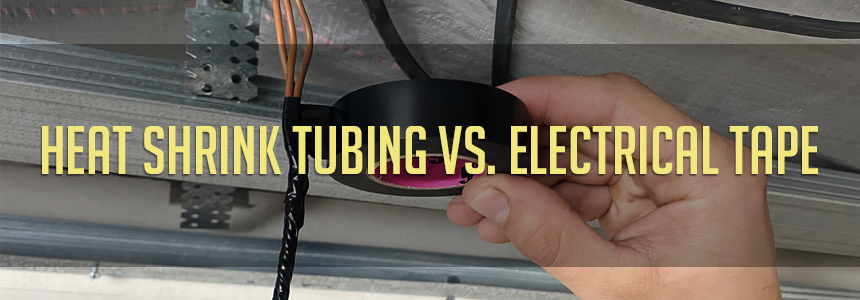Heat Shrink Tubing Vs. Electrical Tape

Heat Shrink Tubing vs. Electrical Tape
Every homeowner, craftsmen and DIYer in the world knows to carry a roll of electrical tape with them in their toolkit at all times. Electrical tape is a common adhesive tape, typically made of vinyl, rubber or mastic that behaves just like any other tape in ease of application.
Electrical tape is known for its flexibility—it may be stretched more than other standard tapes—making it extremely versatile and capable of covering many shapes and cable layouts. When a wire needs repair, electrical tape is often called upon to temporarily seal the connection.
Now, heat shrink tubing gives users the same utility and ease of electrical tape, but with a more durable layer of insulation and longer-lasting seal than tape is able to provide.
How Heat Shrink Tubing Works
Heatshrink tube is the most effective solution for insulating and protecting wires from environmental abrasion and corrosion. We also use heatshrink to repair insulation in wires, as well as when bundling a run of cables so the wires remain tight and organized. Industries from automotive to aerospace, rely on the durable, reliable design heat shrink provides, as they must work with very limited space.
Using Heat Shrink For Abrasion Resistance:
Step 1: Feed cables through a larger piece of heat shrink tube
Step 2: Heat the exterior of the tubing with a heat gun or torch, allowing the tube to shrink down to a tight casing
Step 3: The tube should now be extremely firm, thus promoting durability from mechanical abrasion and improving the operating temperature
Advantages of Electrical Tape
The clear advantage of electrical tape is that it helps provide a near-instant fix to many electrical issues—but this is also its main downside. Too often, electrical tape is applied in an impermanent fashion and expected to last forever. With the proper heat shrink on hand, a safer and longer-lasting solution is only steps away.
Another long-recognized benefit of electrical tape is the color variety it comes available in. Some individuals choose colored electrical tape so it's easier to identify where repairs were required. However, electricians and contractors know the various colors actually indicate and are used to differentiate wire voltage or phases of the wire.
It is essential to monitor the status of your electrical tape, as for all its ease-of-use, electrical tape is also easy to remove, whether it is intentional or happens naturally on its own.
Using Both, But Differently
As stated before, every good contractor carries electrical tape on them at all times, but the great ones also always carry heatshrink. If you were watching an electrician repair exposed wire in your home and their only solution is tape, then get yourself a new contractor—or, better yet, get yourself some heat shrink and do the job yourself!
Choosing the right size tubing is easy with the pre-defined shrink rate and shrink ratio. Simply measure the diameter of whatever wires or cables need to be covered. Keeping a Kit on Hand with various sizes is a great alternative to pulling out the electrical tape.
But don't go throwing away your electrical tape, while it may not offer the same protection as heat shrink, it is easier to apply and remove. It, therefore, remains a good cable management choice for temporary solutions—just don't plan on it for protection against abrasion, corrosion or the elements.














